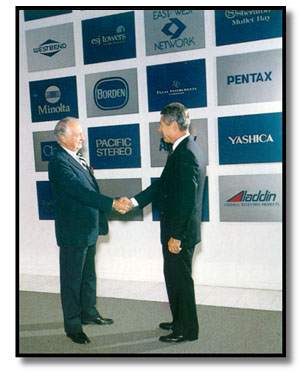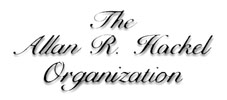|

 In the 1950's a new concept was developed to help companies procure advertising when they had no cash
to buy time and space in the conventional manner. Ever since those early days of barter, The Allan Hackel
Organization (TAHO) has refined the basic concepts of barter into today's sophisticated "Undervalued
Asset Recovery" programs. From old methods to modern ones, the basic advantage has not changed:
Barter can return more economic value than cash liquidation sales!
In the 1950's a new concept was developed to help companies procure advertising when they had no cash
to buy time and space in the conventional manner. Ever since those early days of barter, The Allan Hackel
Organization (TAHO) has refined the basic concepts of barter into today's sophisticated "Undervalued
Asset Recovery" programs. From old methods to modern ones, the basic advantage has not changed:
Barter can return more economic value than cash liquidation sales!
Why Should a Company Consider Barter?
There are only two reasons to participate in an Asset Recovery (barter) program:
1)
A company has an undervalued inventory that could be liquidated at some discounted price, but the
company wants to receive the most possible economic value from that inventory. This includes
companies that want to avoid write downs and write offs and who want to improve their bottom line.
2)
A company wants to advertise but does not have the funds necessary to buy all the desired time or
space on a cash basis; or
This first reason is driven by financial needs and the second is driven by marketing issues. Both types of
barter, however, enable companies to receive significant economic benefits.
How Barter Works
A company with an excess or slow moving inventory is faced with few traditional alternatives if it wants
to sell this inventory. It can always reduce the price and try to sell it through conventional channels. Even
though this can be done, this action will erode anticipated profits. However,
this method creates problems when regular dealers, who bought the product at full price, now learn it is
being sold at a discount.
The other choice is to turn to some third party, such as a closeout liquidator. This can provide an up front
cash infusion, but usually destroys profits because the sales price is often well below cost! Additionally, this
action runs the risk of further upsetting established channels when they learn that some off-price store is
selling the same product to the public at prices lower than the dealer's original cost. When the inventory is
sold to a liquidator, the company loses control of how the product is sold. This can result in irreparable
damage to the company image. Most importantly, the bottom line profit suffers.
TAHO's Asset Recovery programs provide an alternative to traditional cash liquidation options. TAHO's
Full Value Trading program returns the FULL WHOLESALE VALUE of excess merchandise by using it
to replace a portion of the cash the manufacturer planned to spend for budgeted advertising expenses. In
other words, assume the manufacturer budgeted $1,000,000 for spot radio purchases for a fiscal year.
Instead of purchasing the advertising through traditional methods, the company would buy the advertising
through TAHO. The cost of this advertising would still total $1,000,000, however TAHO would accept
(as partial payment) excess product valued at full wholesale. Depending on the time of year, market
conditions, and advertising agency parameters, TAHO might charge the company $600,000 in cash and
$400,000 in excess merchandise.
Economic Benefits
Analyzing the financial and economic benefits of the above example is very straightforward. Instead of
spending $1,000,000 in cash for the budgeted advertising, the company only spent $600,000 in cash. The
$400,000 trade portion paid for with excess merchandise represents $400,000 in CASH FLOW SAVINGS.
|
ECONOMIC BENEFITS |
WITHOUT BARTER |
WITH BARTER |
|
Ad Budget |
$1,000,000 |
$1,000,000 |
|
Cash Portion of Billing |
$1,000,000 |
$600,000 |
|
Trade Portion of Billing |
$0 |
$400,000 |
|
CASH FLOW SAVINGS |
$0 |
$400,000 |
The $400,000 in product used to pay for the advertising was valued at full wholesale. Since this was
excess product that could not have been sold at the normal wholesale price, the company also experienced
INCREASED PROFIT.
Increase the
Bottom Line |
VALUES |
|
Original Wholesale Value |
$400,000 |
|
Value from Trade Sale |
$400,000 |
|
Value from Cash Sale |
$80,000 |
|
INCREASED PROFIT |
$320,000 |
Using $400,000 in product to pay for advertising is financially equivalent to
selling this excess product at the full wholesale price. Many of our clients actually book a sale at full
wholesale for the product utilized in a barter transaction. This INCREASES THE BOTTOM LINE by the
difference between what the excess merchandise could have
been sold for
cash and the
original
wholesale
price at
which the product was
traded.
The Full Value Trading program can be expanded to include the sale of an entire excess inventory, often
totaling several million dollars. As payment for the purchase, TAHO establishes a "bank" of prepaid
(advertising) credits for the exclusive use of the client. This bank of prepaid credits is equal to the total
wholesale value of the excess inventory. When the program is structured in this way, there are significant
BALANCE SHEET ADVANTAGES. The company's auditors would have to write down any inventory
which could only be sold at low liquidation prices. With Full Value Trading, however, the company is
able to book a prepaid expense at least
equal to and often greater than the book value of the surplus inventory. The end result is a healthier balance sheet.
Straight Trade
For companies that do not have the cash necessary to buy advertising, there is a different kind of Asset
Recovery program called Straight Trade. As the name implies, this is a transaction which converts product
directly into advertising or other services. In other words the company buys advertising from TAHO but product is used to
pay 100% of the cost. In the example used above, $1,000,000 of spot radio would be purchased by some
amount of product.
Obviously, it is not possible to trade $1 of advertising for $1 (at wholesale prices) of merchandise. The merchandise used for trading is generally surplus or outdated product. As such, it is worth some amount less
than the original wholesale price. In our experience, the value of the excess inventory could be anywhere
between 10-40% of the original wholesale value. If the spot radio campaign in the above example was
valued at $1,000,000 and the product was only worth 20% of wholesale, the Straight Trade program
would require the company to pay TAHO with $5,000,000 in product.
If this was the case, however, it would make more sense for the company to liquidate $5,000,000 of
product for $1,000,000 and use the revenues to purchase $1,000,000 of advertising directly. TAHO's
services would not be needed.
However, TAHO is able to acquire the advertising for less than $1,000,000. Therefore TAHO can charge
less than $5,000,000 in product. The reason for TAHO's lower acquisition cost is based in the manner in
which TAHO purchases advertising and is described in detail below. For the purposes of this example,
let's assume that TAHO needed $600,000 of actual value to deliver the $1,000,000 campaign. If the
product was worth 20% of wholesale, then TAHO would only require $3,000,000 in surplus product to
deliver the $1,000,000 in advertising.
Click here to read more about the
financial advantages of barter...
A Brief History || Financial Advantages of Barter || Delivery of Advertising || Trade Credits || Credential Letters || Why Barter || Request Client Reference || Links ||
Contact Us

An International Trading Company Established in 1954
1330 Centre Street, Newton Centre, Massachusetts 02159
617-965-4400 FAX 617-527-6005
|